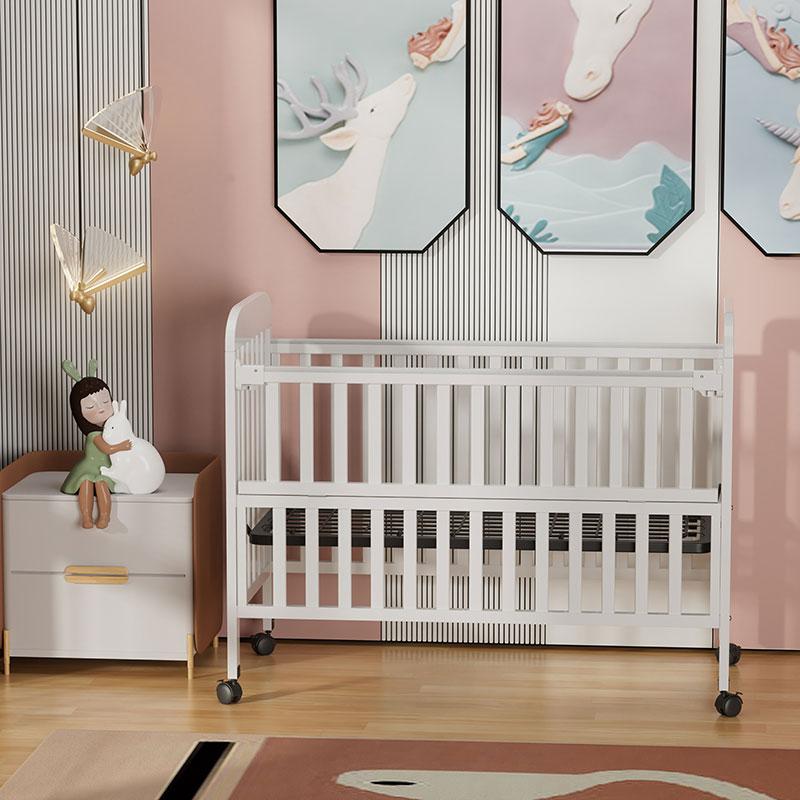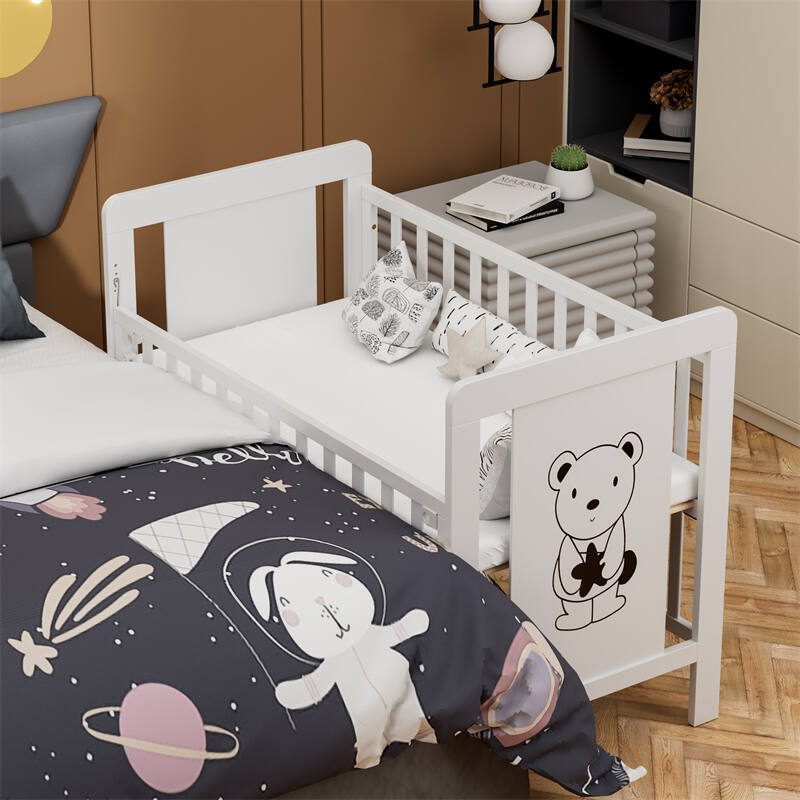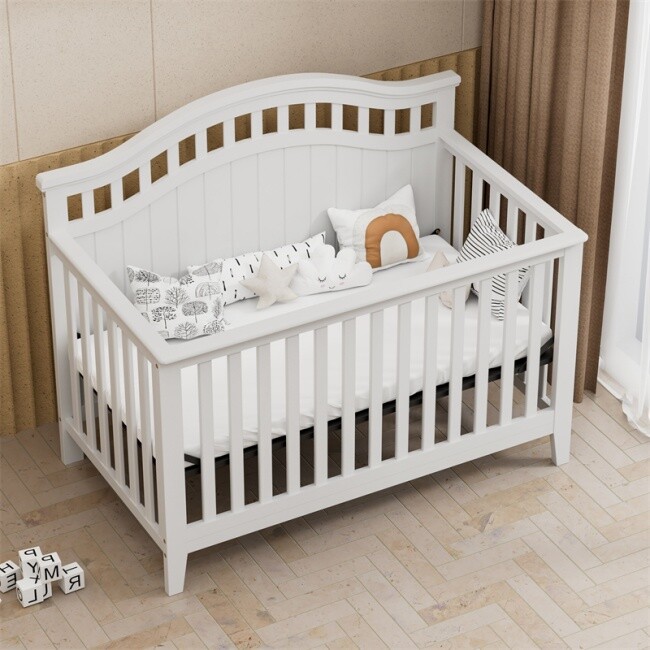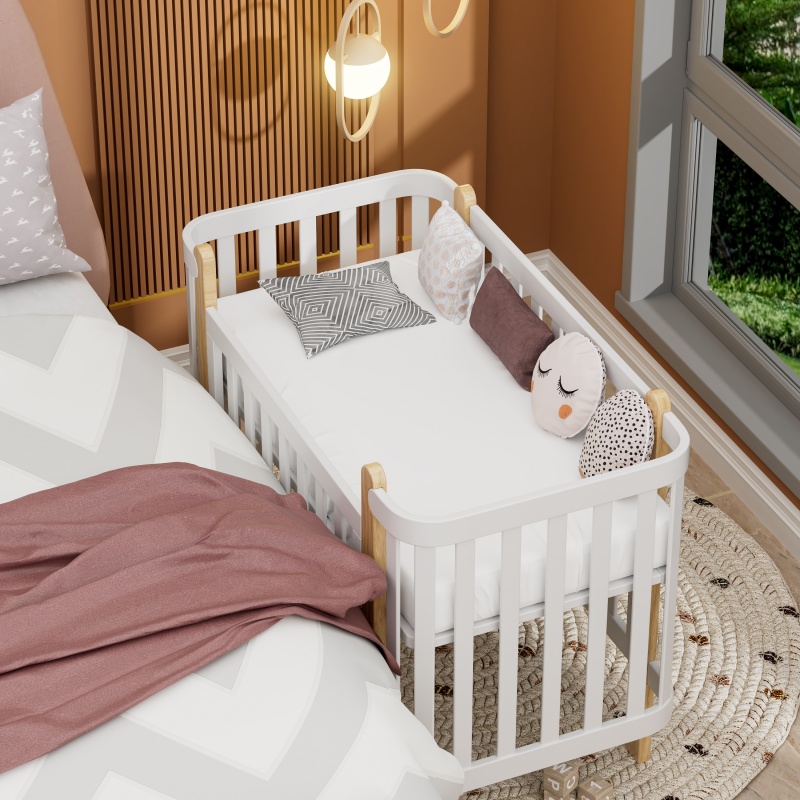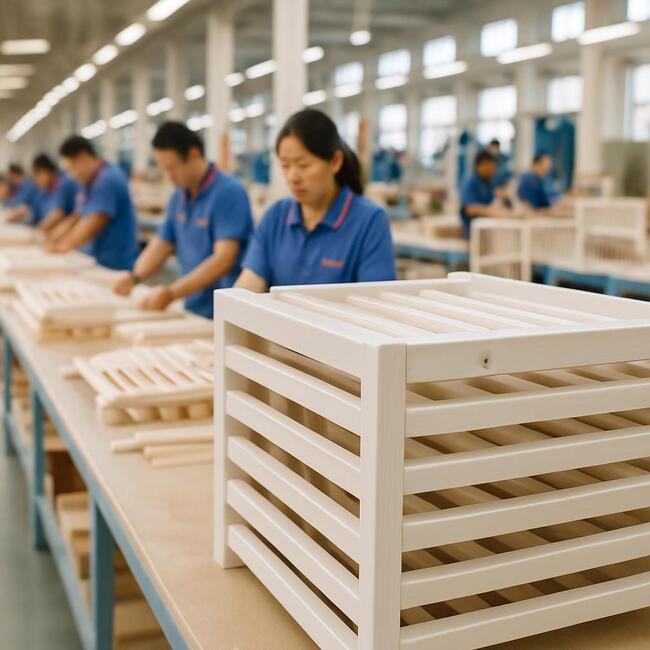You are facing a common challenge: how to fit a safe, full-featured crib into a small living space. This is not just about size; it’s about choosing the right foundation for your baby’s sleep without cluttering your home.
Standard cribs feel too bulky, and the options for ‘mini’ versions can be confusing. As experts in baby furniture manufacturing, we know you need a definitive blueprint. This guide is your expert-level solution—it goes beyond product lists to give you clear decision standards and practical layout secrets. Get ready to transform your limited square footage into a safe, efficient, and beautiful ‘micro-nursery.
What Types of Cribs Are Suitable for Small Spaces?
There are mainly three designs on the market to solve the space challenge. Understanding their differences helps you avoid costly mistakes and saves space and money in the long run.
Mini Cribs
The Mini Crib (typical dimensions: 38-40 inches long, 24 inches wide) is the most compact replacement. A standard crib (typical dimensions: 52 inches long, 28 inches wide) requires 42% more floor space than a mini crib.This makes them perfect for small bedrooms, corners, or even next to the parents’ bed. If you are looking for a permanent, solid crib but have limited space, this is a perfect choice. You need to remember, though, that they need a special-sized mini mattress, not a standard crib mattress.
Foldable Portable Cribs
This type is the champion of flexibility. They are designed to fold flat quickly for easy storage or travel. If you need to move the crib often from the main bedroom to the nursery, or if you take your baby away for the night, a foldable crib is very useful. They are usually lighter than Mini Cribs and can be put away completely when not needed, freeing up the whole room. When choosing, be sure to check that the folding and locking mechanisms are simple and safe.
Co-Sleepers & Bedside Bassinets
This is the option with the smallest footprint. It is often designed to sit right next to the parents’ bed. This offers ease for nighttime feeding and comforting. They are an ideal choice for the newborn stage, giving a close sleep setting that allows parents to tend to the baby without getting up. However, the biggest drawback of co-sleepers is their short lifespan. They can usually only be used until the baby is about six months old or starts trying to roll over. If your budget is tight, you need to think about its lower long-term value.
| Small Crib Type | Feature | Footprint | Portability | Longevity |
|---|---|---|---|---|
| Mini Cribs | A downsized version of a standard crib, offering a sturdy and comfortable sleep space for small rooms. | Compact — fits easily in apartments or shared nurseries | Moderate — not foldable but lightweight enough to move within the home | Moderate — suitable up to around 18–24 months |
| Foldable Portable Cribs | Designed with a collapsible frame for easy storage and travel; ideal for families who move or travel frequently. | Very compact — folds flat when not in use | Excellent — lightweight and easy to transport | Limited — mainly used during infancy (up to 18 months) |
| Co-Sleepers & Bedside Bassinets | Placed next to parents’ bed for convenient nighttime feeding and bonding; often adjustable in height. | Very small — fits beside an adult bed | Excellent — lightweight and easy to move between rooms | Short-term — suitable for newborns up to about 5–6 months |
How Do I Pick the Right Mini Crib?
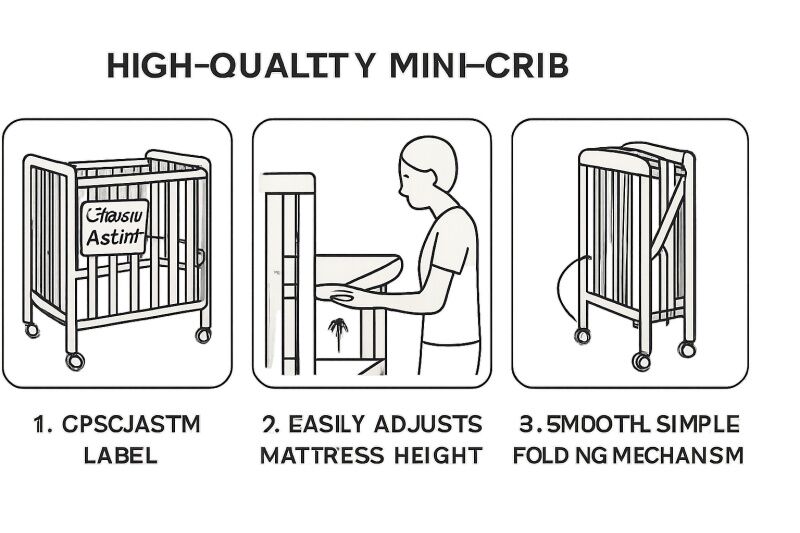
Choosing a crib is a major decision, especially when space is limited. You have to be a smart buyer. Instead of being confused by marketing slogans, focus on three core ‘purchase decision standards.’ These standards will make sure the crib you buy is not just small, but also safe, durable, and truly helps you in daily life.
Is Assembly and Adjustment Easy?
This is a pain point many parents miss when buying a crib. Who wants to spend hours fighting with complex, frustrating instructions and dozens of pieces? For families with small spaces, ease-of-use is not just a convenience; it is a necessity. Complex designs only add frustration when you are working in a small area.
This is what sets Clafbebe and its partner products apart from other makers. We believe that masterful manufacturing should lead to user-friendly, simple operation. A well-designed mini crib should have: Modular Easy Assembly (needs only a few large parts and simple steps to put together), Tool-Free Adjustments (function adjustments should be easy to do without a wrench or screwdriver), and Cleaning-Friendly (surfaces are smooth and easy to wipe down).
Check CPSC and ASTM Official Certifications
You must never compromise on safety. No matter how small a crib is, it has to meet the highest safety standards. In the US, this means looking for certification labels from the Consumer Product Safety Commission (CPSC) and the American Society for Testing and Materials (ASTM). Specifically, verify that the crib meets CPSC 16 CFR 1219 (for standard full-size) or 16 CFR 1220 (for non-full-size, i.e., mini cribs) to ensure the latest anti-entrapment and anti-tip designs are included.
Are Materials and Finish Safe and Durable?
The crib material is not just about looks. It also directly impacts your baby’s health and the furniture’s lifespan. Look for products that use solid wood frames instead of particleboard. Solid wood provides better structure and durability. More importantly, the paints and finishes must be non-toxic and low-VOC (Volatile Organic Compounds). Babies often chew on the crib rails, so the safety of the paint is critical. A durable finish also lets your crib stay looking new after years of use and cleaning.
How to Ensure Safety? Unique Challenges for Small Cribs?
When you use a mini crib in a tight corner or next to a bed, some unique safety challenges can appear. As a parent, you must look beyond standard rail checks. You must pay attention to the potential risks that only a small-space setup brings.
Checking the Mini Mattress Size and Fit
This is the most common safety trap with mini cribs. Mini cribs do not have one standard industry size. This leads to the risk of gaps between the mattress and the frame. If the mattress is too small, your baby’s arms or head could get caught in the gap. This can cause suffocation or injury.
The check rule is simple: try to fit two fingers side-by-side between the mattress edge and the crib frame. If you can fit them easily, the mattress is wrong and must be changed right away. We highly suggest that if you buy a mini crib, you also buy the matching mini mattress from the same manufacturer.
Placement Rules to Avoid Impact Risk
In a small space, it is easy to push the crib into a corner or between furniture to save space. But this can lead to an impact or falling risk. You must strictly follow the CPSC safety guidelines:
- Away from Windows: Curtain cords or blind pull cords are a major suffocation risk.
- Away from Furniture: Every side of the crib should be at least 3 feet (about 91 cm) away from anything that could fall on it, like wall shelves, floor lamps, or unstable cabinets.
How to Place the Crib to Maximize Space?
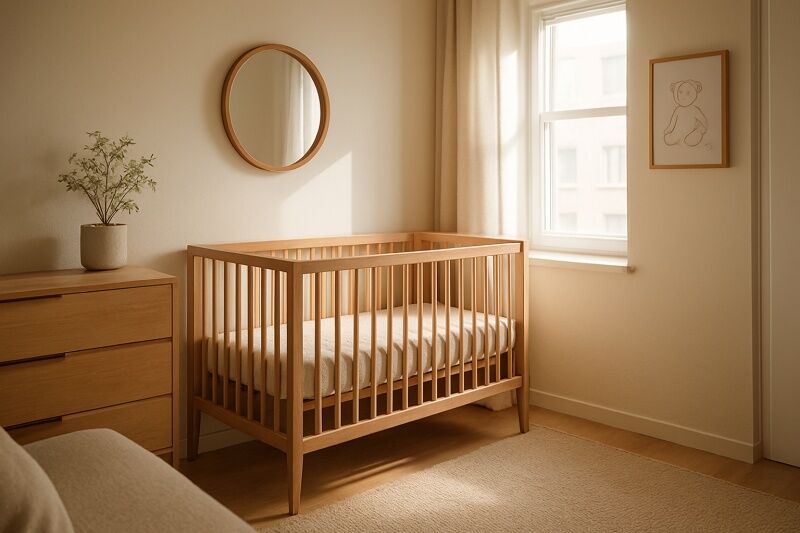
Buying a compact crib is only the first step. Truly turning a small space into an efficient, safe nursery requires smart layout strategies. This is not about squeezing things into the room. It’s about using every inch of vertical space and making the room look bigger with visual tricks.
Layout Core: Vertical Storage and Multi-Functional Furniture
Floor space is the most valuable asset for families in small spaces. Thus, your goal should be to “lift” all storage off the floor.
Vertical Storage is King: Ditch wide bookshelves or short cabinets. Choose wall-mounted shelves or tall, narrow drawer units. This not only gives you lots of storage, but the tall structure draws the eye up, making the room look taller.
Clever Combination of Multi-Functional Furniture: Every piece of furniture should do double duty. For example, choose a crib with built-in drawers or space for storage baskets underneath. Also, a flat, stable dresser top can serve as a diaper changing station, saving the space of a dedicated changing table.
Visual Tricks: The Use of Color and Lighting
You can trick the brain with visuals to make the room appear bigger than it is.
Light Colors Rule: Light-colored walls (like off-white, light gray, or pale mint) maximize the reflection of natural light, making the room feel open and airy. Dark colors absorb light, making the space feel smaller and cramped.
Strategic Mirror Placement: Hang a large mirror on the wall. A mirror reflects the entire room, visually doubling the space right away. Be sure the mirror is securely mounted and far from the crib to follow safety rules.
Layered Lighting: Using only one overhead light creates strong shadows, making the room look crowded. Use layered lighting: a ceiling light, a dimmable floor lamp (placed safely), and a wall-mounted night light. Evenly spread light removes shadows and makes the space softer and more open.
Optimal Crib Placement
In practice, placing a small-space crib is more than just “against a wall.” It is an art of balancing space efficiency with convenience for nighttime care.
Using Corner Placement: This is the most floor-space efficient method, especially good for mini cribs. Safety Tip: The long side of the crib should sit in the corner. But ensure there is enough room on the other side for parents to reach the baby. Most importantly, there must be no shelves, cords, or blinds above or near the corner.
Next to the Parents’ Bed: Placing the crib next to the Parents’ Bed maximizes convenience for nighttime feeding and comfort, making it the ideal spot for a co-sleeper bassinet. Safety Tip: The crib must fit tightly (zero gap). If using a co-sleeper, ensure all locking mechanisms are active, and parent bedding does not hang into the crib.
Against a Single Interior Wall: This placement keeps the room’s flow clearest. Safety Tip: Make sure this is an interior wall (away from outside windows/moisture). Above this wall, you can safely use vertical space for mounted shelving, as long as they are kept a safe distance above the crib top.
Conclusion
You now have all the expert knowledge: from identifying the crib type best suited for your family’s life cycle, to mastering the easy assembly and safe placement techniques, like those found in Clafbebe partner products. Do not let space limit your choices. Our final advice is: Immediately use the safety checklist in this guide (CPSC/ASTM certification and mattress fit) to evaluate your chosen crib.
Recommended Related Articles:

